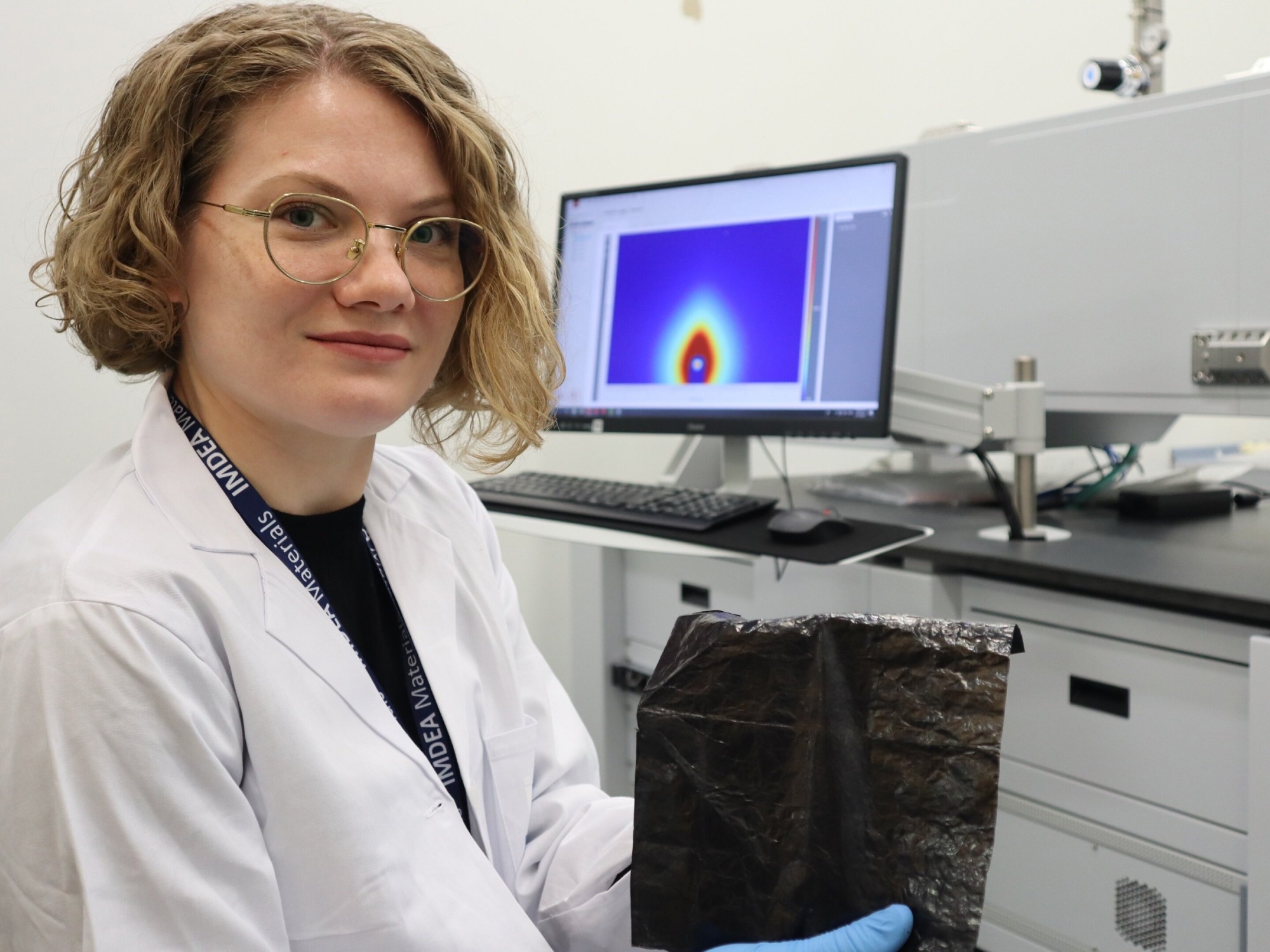High-performance carbon nanotube (CNT) sheets can be recycled while maintaining their shape, structural alignment, mechanical and electrical capabilities, and inherent flexibility, according to ground-breaking research from the IMDEA Materials Institute.

IMDEA Materials researcher Dr. Anastasiia Mikchalchan with a recycled carbon nanotube sheet. Credit: IMDEA Materials Institute
Recently, a special issue of the esteemed journal Carbon published a study titled “Network structure enabling re-use and near full property retention in CNT sheets recycled from thermoset composites.”
It is a major step toward the development of sustainable nanostructured materials and increases the likelihood that carbon nanotube-based fibers, sheets, and textiles will be widely used in the future green energy revolution.
This research represents a crucial step towards manufacturing and usage of sustainable and recyclable CNT fibers and sheets.
Dr. Anastasiia Mikhalchan, Study Co-Principal Investigator and Senior Research Associate, IMDEA Materials
“These will be able to displace widespread CO2-intensive materials, such as conventional carbon fibers and some metals like copper, decreasing our future CO2 emissions footprint. Our work demonstrates that high-performance materials made from carbon nanotubes are recyclable and can be reused in the same application as structural reinforcement or electrical conductors. This is due to the fact that neither their continuity, alignment, and mechanical properties nor their conductivity are affected by recycling. This is the first attempt in this direction, addressing a critical need in the society,” Dr Mikhalchan added.
The study makes use of carbon nanotubes synthesized using the floating catalyst chemical vapor deposition (FCCVD) method, which allows for their fast growth and direct assembly into freestanding network materials.
IMDEA Materials Institute is a global leader in the field, and it is now the only research facility in the European Union capable of synthesizing high-quality nanotube macromaterials.
These CNT fibers and sheets have excellent structural toughness and flexibility, as well as mechanical, electrical, and thermal characteristics. This makes them suitable for structural reinforcement in composite laminates, as well as printable strain/stress sensors, electrical conductors, and flexible battery anodes, among other uses.
Apart from the proven ability to be recycled in the form of macroscopic sheets, the researchers also see the potential for further disintegration of the recycled sheets into their constituent parts, carbon nanotubes, in liquid crystalline solutions. These CNTs could then be respun into a new, superior fiber.
Dr. Mikhalchan further stated, “This prospective is similar to breaking down a LEGO model into its individual bricks, and then re-building the original model with the same shape, robustness, and quality. This is never possible with conventional carbon fibers because their crystalline structure is formed by fused crystallites in the graphitization process, so they cannot be “broken down” into individual crystallites and re-graphitized again into a continuous fiber filament. In contrast, carbon nanotubes are capable of dissolution in superacids and can be re-spun into a fiber, which is a matter of future confirmation.”
The Carbon Hub Initiative, directed by Rice University, is funding this ground-breaking research. Dr. Juan J. Vilatela’s Multifunctional Nanocomposite research group at IMDEA Materials is actively involved in the initiative, as are some of the most esteemed academic institutions in the world, including MIT, Stanford University, University of Cambridge, and Georgia Tech.
To achieve zero emissions in the future, Carbon Hub is pursuing a new paradigm in the sustainable co-production of clean hydrogen and innovative carbon nanostructured materials from natural gas and oil, in collaboration with stakeholders from the oil and gas sector.
The Initiative suggests converting hydrocarbons into high-performance, value-added nanocarbons (like CNT fibers and sheets) that cogenerate net clean energy as (turquoise) hydrogen, as an alternative to burning hydrocarbons to generate energy while releasing gigatons of CO2 into the atmosphere.
The ability of the world to produce CNTs is now at 10 kt/year, and it is growing at a pace of about 30% each year. However, if the Carbon Hub initiatives are successful and nanocarbons begin to displace metals, this might accelerate to the megatone scale.
Another significant step in this trajectory is the study presented by IMDEA Materials researchers, which demonstrates that value-added carbon nanotube materials are recyclable and reusable in the same application by nature.
Similar to ductile polymers in their network structure and innate toughness, they are highly tolerant of flaws and can be recycled and reprocessed into high-value products.
Dr. Mikhalchan added, “Even three years ago, there was little interest in recycling CNT-based materials, but now it is becoming a far more relevant topic. We believe our research will stimulate the scale-up of manufacturing high-performance CNT materials and their faster adoption by industry, knowing that such materials offer sustainability and recyclability and are capable of reducing component weight and industry’s CO2 footprint.”
Along with Dr. Mikhalchan, the individuals who contributed to the latest discovery include Dr. Vilatela, Prof. Carlos González, Dr. Andrea Fernández Gorgojo, a Ph.D. candidate in IMDEA Materials, and former intern Sergio Ramos Lozano.
Journal Reference:
Gómez-Palos, I., et. al. (2024) Gas-to-nanotextile: high-performance materials from floating 1D nanoparticles. Carbon. doi:10.1039/D3NR00289F
Source: https://materials.imdea.org/